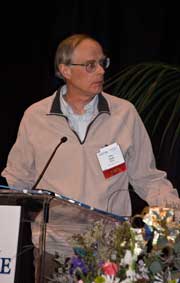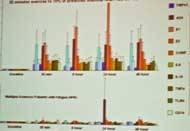The IACFS/ME Conference Reports #IV
The Surprise of the Conference



Reno, Nevada: March 12-16, 2009
By Cort Johnson
______________________________________________________________________________________________________________
And Now For Something Completely Different
Adrenergic and Sensory Receptor Expression on Leukocytes Increases After Moderate Exercise in Chronic Fatigue And Fibromyalgia. Allan Light, A. White, L. Bateman and Kathleen Light.

I was fighting off sleep at this point. We’d just heard about yet another cortisol study a subject that is increasingly wearing me out. Every conference, though, has its surprises. Dr. Bateman said the Utah Group was doing some great stuff but my mouth gaped when I heard this presentation.
Dr. Allan Light has spent his career researching pain. Now that he’s moving into the fatigue field his assessment is that it’s about 30 years behind the pain field in understanding how the problem occurs. He believes both fatigue and pain – two symptoms produced by the brain to signal problems in the body – are created by the same type of system – an interesting theory given how many FM patients experience fatigue and how many ME/CFS patients experience pain.
Dr. Light has done a good deal of background work to get where he could assess what might be causing the fatigue in ME/CFS. First he used laboratory animals to uncover two sets of sensory neurons that appear to relay fatigue and pain signals from the muscles to the brain. He then identified which receptors perceive signs of muscle injury. Once these receptors come across a substance which suggests muscle injury they presumably trigger those neurons to send a signal to the brain. The brain then sends out pain and fatigue messages in an effort to stop us from using those muscles.
Until recently scientists didn’t have a clue what sensory pathways are involved in generating muscle fatigue or muscle pain. The nervous system pathways that generate pain due to exercise have only recently begun to be documented; the pathways that generate muscle fatigue are least well known.”
Dr. Kathleen Light – Offer 2008 Conference
Dr. Light first highlighted what kind of fatigue is present in ME/CFS. Dr. Behan and Chaudhuri about eight years ago asserted that ME/CFS patients exhibit ‘central fatigue’ rather than muscular fatigue; i.e. their fatigue is not due to problems in the muscles but to problems in the central nervous system. Dr. Light also asserted that muscular fatigue – which refers to the ability to contract muscles to produce energy is not the problem in this disease.
But instead of the central nervous system, Dr. Light believes the problem occurs in the body – specifically in the sensors that monitor muscle health. These sensors which are found on white blood cells in the blood – continually monitor the blood for signs of muscle damage i.e. for increased levels of lactate, for low pH (acid)and for purines that are produced during ATP production. They include the:
- ASICS – Acid sensing ion channel – associated with muscle and joint inflammation
- Purinergic X Receptors (P2X4/P2X5) – sensing ATP levels – interestingly the ratio between the two may determine whether one has ME/CFS or fibromyalgia; P2X5 appears to trigger fatigue signals while P2X4 triggers pain signals.
- Vannilloid = sensing heat, acid
Dr. Light also examined receptors from the sympathetic nervous system – which regulates blood flows in response to metabolites out of the muscles, and the immune system.
RESULTS
“Like pain, fatigue is a vital protective sensory experience…. ” Dr. Kathleen Light at the OFFER 2008 Conference
The Lights tested receptor activity at baseline when the patients were at rest and then at varying times after a moderate exercise activity. At baseline, receptor activity was similar except for a few receptors suggesting that chronic fatigue syndrome (ME/CFS) patients had increased ‘vascular resistance’. This appears to suggest that their blood vessels were narrowed – (perhaps in an attempt to maintain blood pressure in the face of low blood volume?).
The post-exercise receptor activity was dramatically different with the visuals in Dr. Light’s charts drawing ‘oohs’ from the audience. (The healthy controls are on the bottom and the CFS/FM patients on the top). The receptors hardly budge in the controls after exercise but they look like Mt. Vesuvius in the CFS/FM patients. ME/CFS patients often feel like they’ve run a marathon after mild exercise; these results suggested that at least one part of their body reacted as if they had.
charts drawing ‘oohs’ from the audience. (The healthy controls are on the bottom and the CFS/FM patients on the top). The receptors hardly budge in the controls after exercise but they look like Mt. Vesuvius in the CFS/FM patients. ME/CFS patients often feel like they’ve run a marathon after mild exercise; these results suggested that at least one part of their body reacted as if they had.
Intense exercise usually causes receptor activity to increase several hours later in healthy people but even mild exercise caused the receptor activity to increase in just 30 minutes in the ME/CFS patients; the finding surprised Dr. Light; not only did the receptors appear to be overreacting in ME/CFS patients they also appeared to be responding surprisingly quickly.
Beginning at 30 minutes after exercise and continuing at eight, 24 and 48 hours after exercise, CFS patients showed increases of the P type of ion channel receptor activity up to four times its pre-exercise level while healthy subjects showed no increase at all. These receptors seemed especially sensitive to fatigue. The graph of the results is incredible; with CFS patients, receptor activity skyrockets while the healthy controls’ results stay essentially at zero.
The activity of a receptor called Type A that’s been implicated in pain doubled in ME/CFS patients who also had FM and showed no increase in healthy subjects at all. Sympathetic nervous system (adrenergic) receptors that detect SNS activity were increased 2-6 times.
How active are these receptors? These sensors, not surprisingly, get really active in marathon runners but they still never got as active in marathoners (after a 26-mile run ) as they did in ME/CFS/FM patients (after a mild 15-minute exercise period). (In this graph the healthy controls are on top, ME/CFS patients on bottom)
as active in marathoners (after a 26-mile run ) as they did in ME/CFS/FM patients (after a mild 15-minute exercise period). (In this graph the healthy controls are on top, ME/CFS patients on bottom)
Interestingly, given all the interest in pro-inflammatory cytokine levels, neither of the two cytokines tested (IL-6, IL-10) exhibited increased activity in the ME/CFS patients. The activity of the anti-inflammatory cytokine IL-10, which appears to be showing up again and again in ME/CFS studies, was increased.
These sensors should react this way only if they were getting constantly triggered by high levels of lactate or acid or purines in the blood. Dr. Light didn’t check to see if those substances were present in high amounts but other studies suggest that they are not elevated in ME/CFS. The only other explanation appears to be that the receptors themselves seem to exist in a state of hypersensitivity – that the smallest amount of lactate, for instance, sends them into a tizzy and they stay that way for a long time. Even at low levels of activity, muscles will produce some lactic acid and ATP; Dr. Light conjectured that chronic fatigue syndrome patients have many times the normal level of these receptors on their white blood cells. Remarkably these receptors were still highly overactive 48 hours after this mild bout of exercise.
“If the number of these receptors were greatly increased in the sensory neurons, resting levels of metabolites could activate sensory fatigue afferents sending a signal of muscle fatigue to the central sympathetic nervous system (SNS), causing dysregulation of SNS reflexes, and to the central nervous system, inducing the cognitive recognition of increased fatigue. “
Dr. Light’s study makes a lot of sense in several ways. It’s been difficult to find evidence of overt muscular damage in either ME/CFS or FM, yet the fatigue and pain found in those diseases is enormous. Researchers have wanted to link the two diseases for years. They share many similarities and often co-occur; doctors report that they often grade into each other. Dr. Light asserts that both diseases display deranged sensory systems; one is producing a lot of pain (and fatigue) and one is producing a lot of fatigue (and pain).
Both often co-occur with other possible ‘sensory’ disorders such as chemical sensitivity and irritable bowel syndrome (IBS). Given the pain evoked by IBS, researchers, for example, expected to find evidence of highly inflamed tissues; but when they examined their intestines they found no evidence of damage at all the problem lies elsewhere – perhaps in heightened levels of pain receptors. Indeed in his paper Dr. Light reported that increased activity levels of some of the same receptors were also found in IBS patients.
He also – in his paper – proposed a model of receptor activation to account for the orthostatic intolerance often seen in this disease. Finally he noted that the central sensitivity syndrome paradigm proposed to explain ME/CFS, FM, IBS and other diseases fits very well with this model of continuous central nervous system activation by the sensory receptors in the body.
We are trying to come up with biological hard, hard science – biomarkers – so that no more of this skepticism and “all in your head” will be part of the future. If these biomarkers give us enough of a clue we may even see… places we can go for innovative new treatments.”
Dr. Kathleen Light at the 2008 OFFER Conference.
Unfortunately Dr. Light was severely limited by time at the conference (and came right out and said so). It seems he was given less time than he had expected so he ripped apart his rather complex presentation and gave us the highlights. (Luckily we had some backup: Dr. Light’s OFFER Presentation and ithe publication of his paper)
Opinion: Too many times during this conference we saw researchers attempt to squeeze really intriguing results into very short time spans while less than scintillating reports seemed to just drag on and on. This was an example of a presentation that needed more space; it was novel, intriguing and it opened important new ground – indeed it proposed a new paradigm for this disease. Very few presentations at the conference could make all three claims . The IACFS/ME should consider highlighting presentations of special value and giving them more space. I heard Dr. Klimas in the row ahead of me exclaim “that was a great study” after Dr. Light’s presentation. Hopefully next time they’ll give him and other innovative researchers the time to fully present their ideas.
Treatment
Is there a way out of the exercise/sensory receptor up-regulation dilemma? Not at the present time but at the 2008 OFFER conference Dr. Kathleen Light cited evidence showing that regular amounts of tolerated exercise/activity do appear to turn down the fatigue/pain response to some extent.
Patients who had been exercising on a regular basis show some reduction in their post-exercise increases in ion channel receptors and sympathetic nervous system receptors although they were still higher than normal. This may be one way exercise training can help to reduce pain and fatigue.”
Of course they are limited by the fact that “exercise even at a moderate level causes worsening pain and fatigue symptoms in these patients at 24 and 48 hours later and sometimes much longer”
A Drug – Researchers have found that injections of Propanolol beta blocker in rats has helped in reducing muscle pain. The same thing was shown in TMJ patients in a single lab test. Dr. Light noted that they’d had a hard time getting this data published
Starting with laboratory animals and moving up to healthy humans and now to fibromyalgia and chronic fatigue syndrome patients, Dr. Light is building a strong foundation for a new model for this disease. This body of work, though, is new not just to the chronic fatigue syndrome research field but to the research field as a whole. Acceptance of his ideas, if they are proved to be correct, will undoubtedly take time. Kudos therefore to the CFIDS Association of America and the National Institutes of Health (NIH) for funding such an innovative and ‘out-of-the-box’ research effort.
“So far as I know we are the only one to have done anything in this direction in human beings at all let alone chronic fatigue syndrome and fibromyalgia patients.” Dr. Kathleen Light
The CDC’s Woes Continue: Gynecological History in Women With CFS: A Population Based Study in Wichita, KS. R. Boneva, J.S. Lin. E. Mahoney, et. al.
The CDC’s presentation at the 2007 Conference wasn’t especially noteworthy but their presence at the 2009 bordered on pitiful and gave weight to Kim McCleary’s report that the program has badly stagnated.
This was one of three studies presented by CDC researchers. This study was from the Wichita cohort, which means the data for it was collected sometime around 2001(!). It’s not that this is a bad study; it’s just that it does little to move the field forward in a significant way. And if anyone should be moving this field forward, it should be the CDC given that their budget is several times higher than any other research group.
It’s doubly unfortunate since the broad subject why women get this disease more than men is an important one that’s hardly been touched on. Dr. Boneva wanted to know if women with chronic fatigue syndrome differ gynecologically from healthy women. Since the disease peaks at about 45 in women just as they’re entering menopause it’s possible that hormonal changes help to trigger it.
There’s much ado about ‘stress’ triggers in this disease but If ME/CFS was the result of accumulative stresses building up over time it should become more prevalent the older we get. Instead it peaks in women at just the time their hormonal systems are undergoing a massive change. Throw in Dr. Moorkens’ finding that pregnancy kicks off the disease in a significant percentage of women and you have to start looking closely at the sex hormones. In fact an earlier study suggested that estrogen availability may be different in women with this disorder. Were estrogen levels different in the women in this study? If the CDC knew, they weren’t telling yet; according to the abstract the CDC did measure sex hormone levels in this group but that finding did not show up in this report.
This study found several gynecological abnormalities in women with ME/CFS: they entered menopause about five years earlier, more of them had had their ovaries removed and they were more likely to have had a hysterectomy. Oddly enough no questions were asked about the rate of miscarriage a seemingly obvious question in a gynecological study.
This was Dr. Boneva’s baby; she may have an interest in this particular subject and may have asked to mine this old dataset (She was apparently not with the program when it was collected). The study was interesting but it’s a decided secondary effort; it relies on old data, it’s not testing out new theories, etc. it’s certainly not the kind of study one would expect the largest ME/CFS research group in the world to highlight at an international conference.
Dig Deeper! For More Reno IACFS/ME Conference Overviews
- Treatment Section Part I and Part II
- The Hit of the Conference” The Whittemore-Peterson Neuro-immune Institute
- Surprise of the Conference
- Whack Those Patients – The Exercise Studies
- Rocking the Conference – Rocking the Research World: Dr Suzanne Vernon at the Mic
